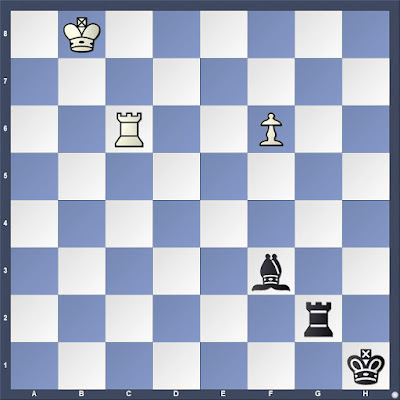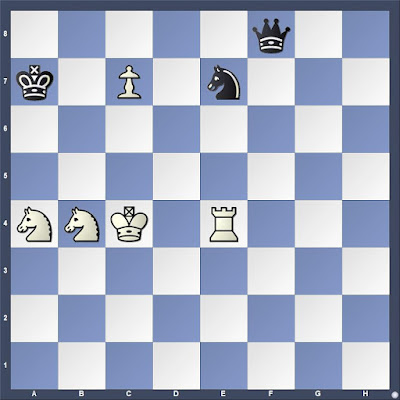Berger makes a point in the first pages to distinguish endgame theory from studies. The endgame, he asserts, "comprises only the battle of a few chess pieces against correspondingly low defensive forces" (2). Compositions leading to checkmate, stalemate, or a draw must be distinguished from endgame theory because, "the chess pieces have a completely different meaning and are used differently than in actual endgames" (2). He presents some illustrations of studies that are not endgames, beginning with a composition by Bernhard Horwitz.
White to move
 |
| Horwitz 1884 |
White to move
1.Kc4 c1Q Or 1...Ka1 2.Qd2 (to avoid an underpromotion threat)
2.Kb3 and checkmate in a few moves.
Berger's eighth example highlights two ways that a theoretical draw of rook vs. bishop is reached from the following position.
White to move
1.f7 Bd5 2.f8Q Rg8
Or
1.Rc1+ Kh2 2.f7 Bd5 3.f8Q Rg8
Following this clarification of endgame theory as distinct from studies, Berger shows elementary checkmates--queen, rook, two rooks, two bishops, and then no less than five positions from which checkmate by bishop and knight can be executed.
Then he turns to the knight. Two knights, as we know, can only stalemate. What about three knights? Berger presents a composition of his that was published in Osterreichische Lesehalle (1889).
Or
1.Rc1+ Kh2 2.f7 Bd5 3.f8Q Rg8
Following this clarification of endgame theory as distinct from studies, Berger shows elementary checkmates--queen, rook, two rooks, two bishops, and then no less than five positions from which checkmate by bishop and knight can be executed.
Then he turns to the knight. Two knights, as we know, can only stalemate. What about three knights? Berger presents a composition of his that was published in Osterreichische Lesehalle (1889).
White to move
When I played this position against the computer, it opted for a line given by Berger as a variation. I was able to coordinate my pieces and win easily.
1.Rxe7 Qd4+
1...Qxe7 leads to 2.c8N+ winning the queen and leading to checkmate. Berger finds a mate 15 moves from the diagram.
1.Rxe7 Qd4+
1...Qxe7 leads to 2.c8N+ winning the queen and leading to checkmate. Berger finds a mate 15 moves from the diagram.

















No comments:
Post a Comment